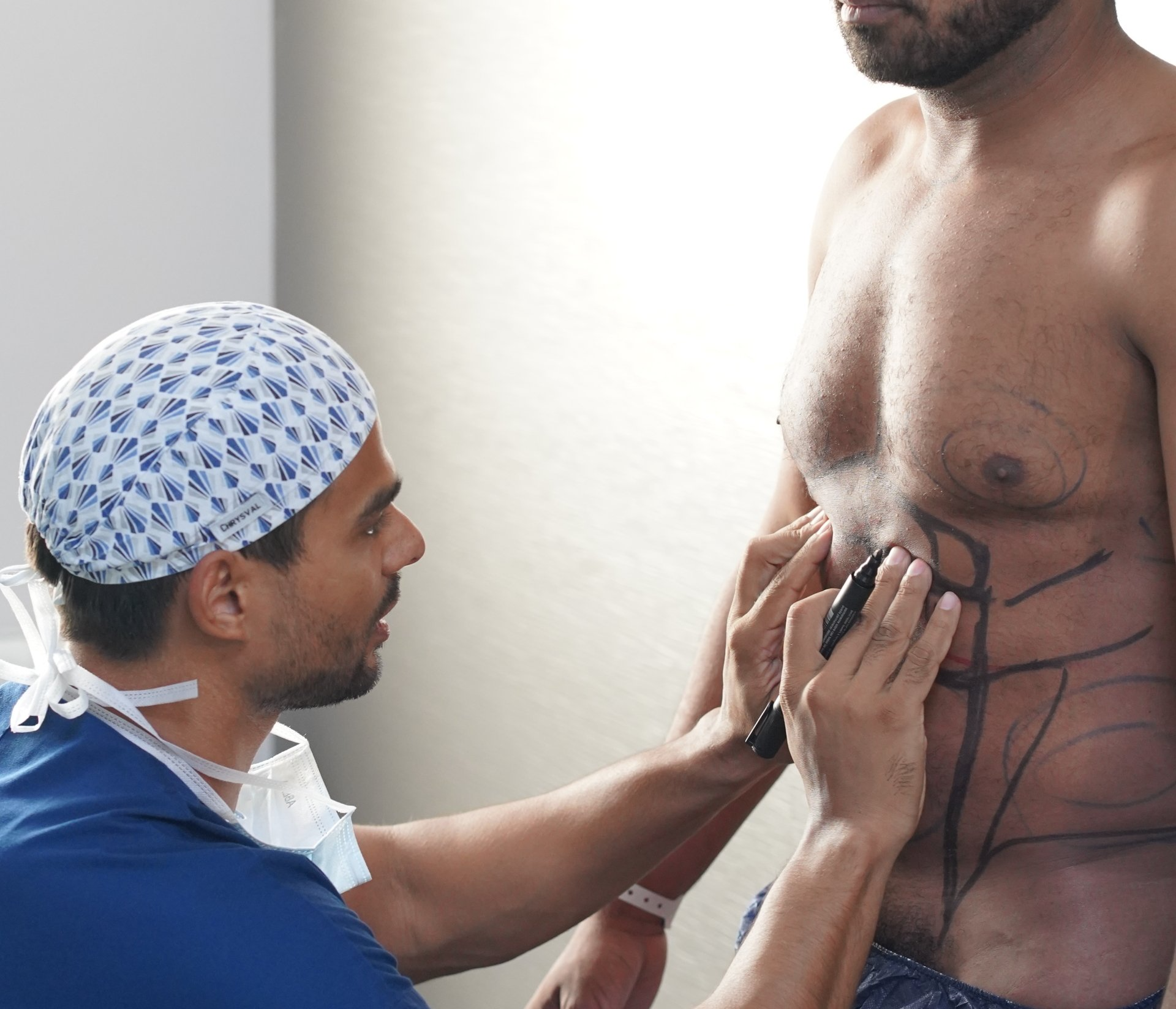Belly liposuction: How to get rid of bulges?
Stomach liposuction, also called abdominal liposuction, is an aesthetic surgical procedure that consists of permanently removing, by suction, excess fat cells in the abdomen. It helps to reshape the belly.
These fatty deposits are of hereditary origin or consecutive to pregnancies, slimming diets, hormonal variations or even related to age. Liposuction is sometimes the only alternative solution to overcome them because they can persist despite slimming diets and sports activities.
Liposuction intervenes to solve this problem and consists in introducing cannulas under the skin via small incisions in order to suck the localized fats.
Effective and easy to perform, this procedure is performed by Doctor Alexis Delobaux, cosmetic surgeon in Bordeaux, qualified and recognized by the Order of Physicians. The risks associated with this operation are therefore very limited.
Liposuction of stomach and hips (love handles)
Liposuction of the belly aims to refine the waist but can also be combined with liposuction of the hips or flanks (fat at the level of the "love handles") to obtain a better result depending on the case.
Liposuction of the buoy (flanks and subumbilical part) in men
From the age of 40, fat tends to settle below the navel and on the flanks. This phenomenon is much more noticed in men, it is called the buoy. Liposuction is also indicated in this case.
Liposuction of the abdomen at menopause in women
Menopause, occurring for hormonal reasons, leads to localized fat storage in the abdomen. Liposuction intervenes and helps to get rid of it.
Stomach liposuction procedure
On the day of the operation, Dr. Alexis Delobaux first draws the drawings on specific areas that are to be treated, this gives you the opportunity to ask him the last questions about the operation.
Then, the medical team (anesthesiologist) and paramedical staff take care of you and install you in the operating room. The intervention takes place under general anesthesia, or similar to epidural anesthesia according to the choice of the patient, the evaluation of the anesthetist and the areas to be treated.
The operation lasts 45 min to 1h30/2h depending on the case, after anesthesia small incisions of a few millimeters are made to start the infiltration of a saline solution with adrenaline and a local anesthetic to reduce bleeding and increase your comfort upon waking.
Doctor Alexis Delobaux first passes the ultrasound probe under the skin in the deep and superficial fat to liquefy it and facilitate its removal and the tightening of the fat cells in your belly. The fat is then aspirated using a conventional cannula and in a gentle and non-traumatic way since it has been liquefied beforehand. This allows a significant reduction in edema, bruising and bleeding compared to conventional liposuction.
When you return home, complete and effortless rest will be observed and a work stoppage of 7 to 15 days is recommended.
You will resume sports activities after 4 weeks and avoid all tobacco consumption and sun exposure.
You will see your surgeon several times for check-ups.
A compression garment will be worn for 4 to 6 weeks after the operation.
The pain may persist for a few days but you will have all the prescriptions necessary for your comfort.
The result is final and visible between the third and sixth month.
Any variation in weight will lead to a variation in results, so it is up to you to take care of your lifestyle to avoid significant weight variations.
How is the preoperative consultation carried out?
During the first preoperative consultation, the Delobaux surgeon assesses the state of the patient's stomach: abdominal wall, skin surface, volume of fat. It presents the possible contraindications, explains the course of the intervention and the possible consecutive pains. A pre-operative blood test is carried out according to the prescriptions at least 15 days before the operation. The anesthesiologist must be consulted at least 48 hours before the operation. The cosmetic surgeon asks the patient, if it is possible, to have a weight closer to his normal weight.
What is the length of hospitalization?
Hospitalization often takes place on an outpatient basis (entrance and exit the same day) but for certain major liposuctions a 24-hour hospitalization remains essential.
What type of anesthesia is performed?
The type of anesthesia to be performed depends on the quantity of excess fat to be aspirated and the trilogical relationship that exists between “the actors”, ie the consultation between the plastic surgeon, the anesthesiologist and the patient. For liposuction that treats small areas, local anesthesia or anesthesia under neuroleptanalgesia can be performed. When the areas to be treated are numerous or large, belly liposuction is performed under general anesthesia for the patient's comfort.
How long does the actual operation take?
The procedure lasts between 30 minutes and an hour depending on the amount of fatty deposits to be sucked out, and the number of areas to be treated.
What are the postoperative consequences after abdominal liposuction?
The postoperative course is more uncomfortable than painful and treatment with analgesics is sufficient to relieve them. Edema (swelling) and ecchymoses (bruises) hide the result during the post-operative period but gradually resorb in 5 to 15 days. Showers are allowed the following day. It is advisable to drink plenty of water the days following a major liposuction. The compression garment is to be worn for 2 weeks full-time then part-time for the following 2 weeks. The results are gradually visible as the edema melts. After about 3 weeks or 1 month, they are clearly visible but will improve further. Manual lymphatic drainage accelerates the postoperative course. The time required for recovery depends on the amount aspirated. It will be necessary to plan a short work stoppage, depending on the importance of the abdominal liposuction and your professional activity. The resumption of sport will be done gradually according to the exercise envisaged.
Are the consequences painful?
The pain is moderate and looks more like cramps or aches. They are relieved by simple analgesics. Fatigue is the symptom often felt especially in large liposuctions. A compressive bandage (Velpeau bandage or elastoplast) is placed for 24 hours on the operated area. Small blood flows may occur the first 24 hours at the level of the short incisions. Edema or ecchymoses (bruises) usually occur but they disappear naturally after a few days. Doctor Delobaux can, if he deems it necessary in certain cases (liposuction of a large quantity, multiplicity of areas to be treated) prescribe a treatment with iron and folic acid in order to avoid any anemia following the intervention of liposuction.
For how long should a compression sheath be worn?
Wearing a specific compression sheath or panty is recommended for 2 to 4 weeks (day and night at the start) after the operation depending on the quantity of fat removed and the quality of the initial skin. However, it is important to remove it when taking showers to avoid any maceration of the scars. This support sheath or panty optimizes the result of liposuction by limiting edema and promoting skin retraction.
Are the scars visible?
The incision scars are minimal, the sutures are absorbable. The dressings placed on these scars fall off spontaneously after a few days (replacing them is not useful). At first pink, they are most often almost impossible to find within 1 year.
Is a work stoppage necessary?
Work can be resumed for a few days after the intervention if the professional activity is sedentary or moderate. The resumption of sports activities is gradually possible after a few days or a month following the intervention.
What are the risks and complications following abdominal liposuction?
Whatever the surgery performed, cosmetic or not, risks or complications may exist, but remain exceptional.
Medical risks
Thromboembolic accidents such as phlebitis and pulmonary embolism are medical risks related to anesthesia and surgery, but are extremely rare with the systematic wearing of compression stockings, coagulant treatment and getting up early the evening of the operation. The pre-operative consultations with the cosmetic surgeon and then the anesthesiologist aim to monitor and prevent risks and complications as much as possible. A hematoma (or internal bleeding) is almost impossible because there is no detachment zone (like an abdominoplasty) likely to bleed, on the other hand there are bruises, systematic, which are resorbed in a few weeks. The occurrence of an infection may require surgical drainage associated with antibiotic treatment. Initial metabolic disturbances or even anemia may occur if a large amount of fat is removed. Anemia is most often quickly resolved with treatment with folic acid. It is often prevented by taking iron for 10 days before the procedure. Sensitivity disorders can be felt but fade after a few weeks. The delayed onset of a lymphocele (pocket of lymphatic fluid behind the skin of the lower abdomen). This complication is exceptional and drainage in consultation is sufficient to treat it.
The imperfection of result
A non-smooth aspect or an asymmetry can be noticed but are rare. This imperfection is linked to the technique (use of a cannula that is not thin enough and inhomogeneous removal of fat) and to the indication (poor skin quality with inelastic skin). If surgical revisions prove to be essential, they are most often done under local anesthesia with simple gestures.
The limits of this surgical treatment
Belly liposuction does not correct overweight and therefore cannot be a means of losing weight or treating obesity. The objective pursued by belly liposuction is to reshape an unsightly belly suffering from excess fat. This surgical intervention therefore does not dispense with an improvement in the hygiene of life. Liposuction is not an abdominoplasty and therefore cannot treat cases of sagging skin or distension of the abdominal muscles (diastasis of the rectus). Abdominal liposuction with mini-abdominoplasty which was mandatory given the excess skin to be treated.
The results: A flat stomach!
The first results will be visible immediately after belly liposuction. Your silhouette is visibly more harmonious. However, it takes three months for the results to fully settle in, while the swelling and bruising subside. The skin adapts to the new volume of the abdomen and then gradually retracts. You will have to see the surgeon again for regular check-up consultations which will allow him to assess the evolution of the results of your belly liposuction. If he notices an imperfection in the result, he can then make some corrections that only require simple gestures on an outpatient basis. A delay of about three months between your belly liposuction and the corrective intervention must however be respected. It will take about 12 months for your scars to fade and you can appreciate the result as a whole. Today, belly liposuction offers optimal results. The belly is flatter and redesigned. Liposuction of the belly allows to have a lasting and definitive and satisfactory result. Indeed, fat cells or adipocytes do not have the ability to multiply. The result is then entirely satisfactory and radical. Nevertheless, it is necessary to follow a healthy lifestyle. Fat cells can move to other areas of your body and weight gain after liposuction is unsightly. The quality of the result of liposuction depends on the elasticity and tone of your skin. If the quality of it is optimal, it will tighten naturally after the intervention.
Belly liposuction cost
The results offered by this type of technique are far superior to those of conventional liposuction. This is explained by the technology using ultrasound which allows a greater elimination of fat at the level of all layers. The technologies used are expensive and require special maintenance due to their fragility. The price will therefore depend on the number of areas to be treated. Abdomen only: from 4950€ Abdomen and Flanks: from 5950€
Can it be reimbursed by Social Security?
Belly liposuction is not covered by social security.
How to know the price of liposuction of the belly?
To find out more about the pricing conditions, visit the official website of Doctor Alexis Delobaux, or contact customer service at the following number: 06 73 43 43 47.
Get an appointment
All interventions






